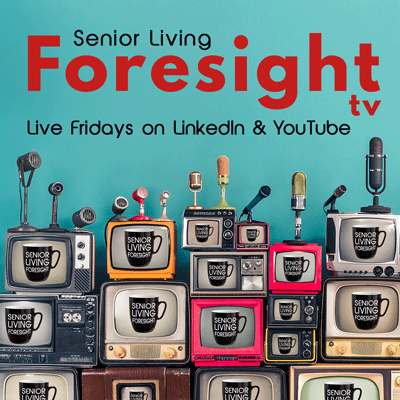By Jack Cumming
A great mind yearns for learning, knowledge, and understanding. Great are those rare people like Socrates, Copernicus, Einstein, Moon, and Lewis.
Moon and Lewis?
Don Moon and Lloyd Lewis were shapers of the modern world of senior living. They had that obsession with the frontier of human endeavor that greatness requires. Greatness belongs to those who do not fear the abyss, and by taking that leap, they lead the way to betterment for all.
Beyond the Abyss
With that paradigm in mind, what follows is the question: Where is the frontier of greatness in senior living now? My candidate for emergent greatness would be a transformer who puts consumers first, beyond corporate interests. That person (or persons) may be a current industry leader, or it may be someone from outside who sees an opportunity. As Jill Vitale-Aussem has advocated, the industry can benefit from a power reversal in favor of residents.
Today’s industry associations reflect the mindset of the industry. Consumers, residents, and their families play but a minor role in industry gatherings. Reversing that mindset to put consumers first — citizens, not subjects, in their communities — requires courage and wisdom. Ms. Vitale-Aussem has taken a first step in that reversal. Opportunity lies in inverting the power pyramid. Residents, and those who serve their immediate needs, can be at the top. Executives will then be the foundation to sustain the greater good.
A Parallel
Perhaps we can think of AARP, once the “American Association of Retired Persons.” AARP was founded as a grassroots organization of consumer members. Leonard Davis, a co-founder of AARP with Ethel Percy Andrus, also founded Colonial Penn Life Insurance Company. AARP’s predecessor organization was initially formed to help retired teachers find health insurance in the years before Medicare. Colonial Penn was part of that calling even after Medicare was in place.
That would be as if LeadingAge had been formed as a nonprofit organization to help older Americans find affordable and suitable housing. It, too, might have formed an insurance enterprise. Click here for info about the 1961 origin of what is now LeadingAge as an association of providers.
An insurance affiliation might have enabled LeadingAge to put consumer-oriented concepts like care-inclusive contracts (Type A in industry parlance) on a sound basis with which providers could be comfortable. The prepayment of future costs through entry fees might have been insured, providing resident-protective performance guarantees.
Intriguingly, LeadingAge is a 501(c)(3) tax-qualified organization while AARP is a 501(c)(4) and neither is a 501(c)(6). The “quasi-mutual” insurance of the Auto Club of Southern California is qualified as a 501(c)(9). Google “IRS 501(c) classifications” to understand these nuances. It could have been different. It might have been different. LeadingAge might have been more like AARP.
Ministry or Interest Group?
“Would’ve, could’ve, should’ve,” however, do not give us much that’s practical for today’s senior living industry. Don Moon and Lloyd Lewis saw opportunity in meeting needs. Their ministry to aging people took precedence over business interests, though they were not naive about soundness. Their legacy persists to this day.
The Philadelphia Yearly Meeting of the Religious Society of Friends supported both Moon and Lewis in their ministry. Perhaps it’s reflective of the anti-hierarchical structure of a typical Friends meeting that it is the Quakers who have often led in the human response to aging and its challenges. We can ask ourselves, if we returned to that consensus model of service, what would be the comparable call of greatness in senior living today?
Grassroots Organization
We can go back to the grassroots origins of AARP to find guidance to show us the path of greatness for senior living today. Many years ago, Alexis de Tocqueville observed that one outgrowth of democracy was that Americans organized themselves for their common good. We are at our best when we come together among ourselves to solve shared challenges.
We see that today in the grassroots evolution of the Village Movement, by which aging people in a community come together to help each other, or in the concept of cohousing, which was nascent in 1988 when Kathryn McCamant and Charles Durrett published Cohousing: A Contemporary Approach to Housing Ourselves. Grassroots movements naturally emerge more slowly than enterprise. Capital moves quickly to find monetary opportunity, while people take longer to find each other and to organize themselves.
Whither the Future?
Will the future of senior housing be at the consumer level, or will it continue to follow a corporate structure? That is the question that we ponder here. AARP is perhaps an example. It has preserved its grassroots origins even as its primary corporate insurance affiliation shifted from Colonial Penn to UnitedHealthcare.
Kendal Crosslands recently withdrew from its affiliation with Kendal Corporation. Amazon upended retailing with a founder who obsessed about the customer and who put customer value before profit harvesting. One of the paradoxes of American business is that growth and prosperity often come to those who put others first before corporate self-interest and who favor customer empowerment and value over corporate power and defensive public policy.
Imagine LeadingAge as a grassroots consumer organization instead of as a functional trade association of providers.
Who, How, and When?
Who will have the greatness to see that bright future with clarity? That calls for a clairvoyance beyond the conventionality of today’s industry concerns. My hope is that greatness can restore that early purpose that gave us great leaders like Don Moon and Lloyd Lewis.
Can today’s CCRC be tomorrow’s resident-oriented cohousing enterprise? Of course, it can. Will today’s central office CCRC executives be content to be tomorrow’s property managers serving to make senior living empowering, seamless, and carefree? Perhaps.
Time will tell.





